Rhubarb
Rhubarb is a vegetable derived from cultivated plants in the genus Rheum in the family Polygonaceae.[2] The whole plant – a herbaceous perennial growing from short, thick rhizomes – is also called rhubarb. Historically, different plants have been called "rhubarb" in English. The fleshy, edible stalks (petioles) of other species and hybrids (culinary rhubarb) were cooked and used for food. The large, triangular leaves contain high levels of oxalic acid and anthrone glycosides, making them inedible. The small flowers are grouped in large compound leafy greenish-white to rose-red inflorescences.
| Rhubarb | |
|---|---|
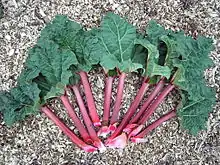 | |
| Scientific classification | |
| Kingdom: | Plantae |
| Clade: | Tracheophytes |
| Clade: | Angiosperms |
| Clade: | Eudicots |
| Order: | Caryophyllales |
| Family: | Polygonaceae |
| Genus: | Rheum |
| Species: | R. . (?) |
| Binomial name | |
| Rheum × hybridum (?) | |
| Nutritional value per 100 g (3.5 oz) | |
|---|---|
| Energy | 88 kJ (21 kcal) |
4.54 g | |
| Sugars | 1.1 g |
| Dietary fiber | 1.8 g |
0.3 g | |
0.8 g | |
| Vitamins | Quantity %DV† |
| Thiamine (B1) | 2% 0.02 mg |
| Riboflavin (B2) | 3% 0.03 mg |
| Niacin (B3) | 2% 0.3 mg |
| Pantothenic acid (B5) | 2% 0.085 mg |
| Vitamin B6 | 2% 0.024 mg |
| Folate (B9) | 2% 7 μg |
| Choline | 1% 6.1 mg |
| Vitamin C | 10% 8 mg |
| Vitamin E | 2% 0.27 mg |
| Vitamin K | 28% 29.3 μg |
| Minerals | Quantity %DV† |
| Calcium | 9% 86 mg |
| Iron | 2% 0.22 mg |
| Magnesium | 3% 12 mg |
| Manganese | 9% 0.196 mg |
| Phosphorus | 2% 14 mg |
| Potassium | 6% 288 mg |
| Sodium | 0% 4 mg |
| Zinc | 1% 0.1 mg |
| |
| †Percentages are roughly approximated using US recommendations for adults. Source: USDA FoodData Central | |
The precise origin of culinary rhubarb is unknown. The species Rheum rhabarbarum (syn. R. undulatum) and R. rhaponticum were grown in Europe before the 18th century and used for medicinal purposes. By the early 18th century, these two species and a possible hybrid of unknown origin, R. × hybridum, were grown as vegetable crops in England and Scandinavia. They readily hybridize, and culinary rhubarb was developed by selecting open-pollinated seed, so that its precise origin is almost impossible to determine.[3] In appearance, samples of culinary rhubarb vary on a continuum between R. rhaponticum and R. rhabarbarum. However, modern rhubarb cultivars are tetraploids with 2n = 44, in contrast to 2n = 22 for the wild species.[4]
Although rhubarb is a vegetable, it is often put to the same culinary uses as fruits.[5] The leaf stalks can be used raw, when they have a crisp texture (similar to celery, although it is in a different family), but are most commonly cooked with sugar and used in pies, crumbles and other desserts. They have a strong, tart taste. Many cultivars have been developed for human consumption, most of which are recognised as Rheum × hybridum by the Royal Horticultural Society.[6]
Cultivation
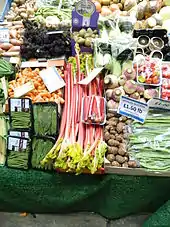
Rhubarb is grown widely, and with greenhouse production it is available throughout much of the year. Rhubarb grown in hothouses (heated greenhouses) is called "hothouse rhubarb", and is typically made available at consumer markets in early spring, before outdoor cultivated rhubarb is available. Hothouse rhubarb is usually brighter red, tenderer and sweeter-tasting than outdoor rhubarb.[7] In temperate climates, rhubarb is one of the first food plants harvested, usually in mid- to late spring (April or May in the Northern Hemisphere, October or November in the Southern Hemisphere), and the season for field-grown plants lasts until the end of summer.
In the United Kingdom, the first rhubarb of the year is harvested by candlelight in forcing sheds where all other light is excluded, a practice that produces a sweeter, more tender stalk.[8] These sheds are dotted around the "Rhubarb Triangle" between Wakefield, Leeds, and Morley.[9]
In the northwestern US states of Oregon and Washington, there are typically two harvests, from late April to May and from late June into July;[10] half of all US production is in Pierce County, Washington.[11] Rhubarb is ready to consume as soon as harvested, and freshly cut stalks are firm and glossy.
Rhubarb damaged by severe cold should not be eaten, as it may be high in oxalic acid, which migrates from the leaves and can cause illness.[12]
The colour of rhubarb stalks can vary from the commonly associated crimson red, through speckled light pink, to simply light green. Rhubarb stalks are poetically described as "crimson stalks". The colour results from the presence of anthocyanins, and varies according to both rhubarb variety and production technique. The colour is not related to its suitability for cooking.[13]
Historical cultivation

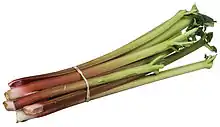
The Chinese call rhubarb "the great yellow" (dà huáng 大黃), and have used rhubarb root for medicinal purposes for thousands of years.[14] It appears in The Divine Farmer's Herb-Root Classic, which is thought to have been compiled about 1,800 years ago.[15] Though Dioscurides' description of ρηον or ρά indicates that a medicinal root brought to Greece from beyond the Bosphorus may have been rhubarb, commerce in the drug did not become securely established until Islamic times. During Islamic times, it was imported along the Silk Road, reaching Europe in the 14th century through the ports of Aleppo and Smyrna, where it became known as "Turkish rhubarb".[16] Later, it also started arriving via the new maritime routes, or overland through Russia. The "Russian rhubarb" was the most valued, probably because of the rhubarb-specific quality control system maintained by the Russian Empire.[17]
The cost of transportation across Asia made rhubarb expensive in medieval Europe. It was several times the price of other valuable herbs and spices such as cinnamon, opium, and saffron. The merchant explorer Marco Polo therefore searched for the place where the plant was grown and harvested, discovering that it was cultivated in the mountains of Tangut province.[15] The value of rhubarb can be seen in Ruy Gonzáles de Clavijo's report of his embassy in 1403–05 to Timur in Samarkand: "The best of all merchandise coming to Samarkand was from China: especially silks, satins, musk, rubies, diamonds, pearls, and rhubarb ..."[18]
The high price as well as the increasing demand from apothecaries stimulated efforts to cultivate the different species of rhubarb on European soil.[17] Certain species came to be grown in England to produce the roots.[19] The local availability of the plants grown for medicinal purposes, together with the increasing abundance and decreasing price of sugar in the 18th century, galvanised its culinary adoption.[17] Grieve claims a date of 1820 in England.[19] Rhubarb was grown in Scotland from at least 1786, having been introduced to the Botanical Garden in Edinburgh by the traveller Bruce of Kinnaird.[20]
Though it is often asserted that rhubarb first came to the United States in the 1820s,[21] John Bartram was growing medicinal and culinary rhubarbs in Philadelphia from the 1730s, planting seeds sent to him by Peter Collinson.[22] From the first, the familiar garden rhubarb was not the only Rheum in American gardens: Thomas Jefferson planted R. undulatum at Monticello in 1809 and 1811, observing that it was "Esculent rhubarb, the leaves excellent as Spinach."[23]
Cultivars
The advocate of organic gardening Lawrence D. Hills listed his favourite rhubarb varieties for flavour as ‘Hawke's Champagne’, ‘Victoria’, ‘Timperley Early’, and ‘Early Albert’, also recommending ‘Gaskin's Perpetual’ for having the lowest level of oxalic acid, allowing it to be harvested over a much longer period of the growing season without developing excessive sourness.[24]
The following cultivars have gained the Royal Horticultural Society’s Award of Garden Merit:[25]
Etymology
_Frambozenrood_bloeiwijze.jpg.webp)
The word rhubarb is likely to have derived in the 14th century from the Old French rubarbe, which came from the Latin rheubarbarum and Greek rha barbaron, meaning 'foreign rhubarb'.[30] The Greek physician Dioscorides used the Greek word ῥᾶ (rha), whereas Galen later used ῥῆον (rhēon), Latin rheum. These in turn derive from a Persian name for species of Rheum.[31] The specific epithet rhaponticum, applying to one of the presumed parents of the cultivated plant, means 'rha from the region of the Black Sea'.[31]
Uses
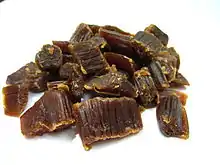
Rhubarb is grown primarily for its fleshy leafstalks, technically known as petioles. The use of rhubarb stalks as food is a relatively recent innovation. This usage was first recorded in 18th to 19th-century England after affordable sugar became more widely available.[17][19]
Commonly, it is stewed with sugar or used in pies and desserts, but it can also be put into savoury dishes or pickled. Rhubarb can be dehydrated and infused with fruit juice. In the United States, it is usually infused with strawberry juice to mimic the popular strawberry rhubarb pie.
Food
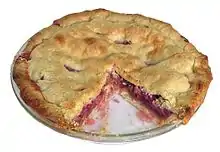
The species Rheum ribes has been eaten in the Islamic world since the 10th century.[32]
In Northern Europe and North America the stalks are commonly cut into pieces and stewed with added sugar until soft. The resulting compote, sometimes thickened with corn starch, can then be used in pies, tarts and crumbles. Alternatively, greater quantities of sugar can be added with pectin to make jams. The most popular accompanying spice to use is ginger, although cinnamon and nutmeg are also popular additions.
In the United Kingdom, as well as being used in the typical pies, tarts and crumbles, rhubarb compote is also combined with whipped cream and/or custard to make respectively rhubarb fool and rhubarb and custard.
In the United States the common usage of rhubarb in pies has led to it being nicknamed ‘pie plant’, by which it is referred to in many 19th century US cookbooks.[33] Rhubarb in the US is also often paired with strawberries to make strawberry-rhubarb pie, though some rhubarb purists jokingly consider this "a rather unhappy marriage".[33]
In former days, a common and affordable sweet for children in parts of the United Kingdom and Sweden was a tender stick of rhubarb, dipped in sugar. It is still eaten this way in western Finland, Norway, Canada, Iceland, Latvia, Lithuania, the Faroe Islands and Sweden, and also some other parts of the world.
Rhubarb can also be used to make alcoholic drinks, such as fruit wines or Finnish Rhubarb sima (mead). It is also used to make Kompot.[34]
Traditional Chinese medicine
In traditional Chinese medicine, rhubarb roots of several species were used as a laxative for several millennia,[35] although there is no clinical evidence to indicate such use is effective.[36][37]
Phytochemistry and potential toxicity
The roots and stems contain anthraquinones, such as emodin and rhein.[14] The anthraquinones have been separated from powdered rhubarb root for purposes in traditional medicine,[35] although long-term consumption of the plant has been associated with acute kidney failure.[36]
The rhizomes contain stilbenoid compounds (including rhaponticin), and the flavanol glucosides (+)-catechin-5-O-glucoside and (−)-catechin-7-O-glucoside.[38]
Oxalic acid
Rhubarb leaves contain poisonous substances, including oxalic acid, a nephrotoxin.[36] The long term consumption of oxalic acid leads to kidney stone formation in humans. Humans have been poisoned after ingesting the leaves, a particular problem during World War I when the leaves were mistakenly recommended as a food source in Britain.[39][40][41] The toxic rhubarb leaves have been used in flavouring extracts, after the oxalic acid is removed by treatment with precipitated chalk (i.e., calcium carbonate).
The LD50 (median lethal dose) for pure oxalic acid in rats is about 375 mg/kg body weight,[42] or about 25 grams for a 65-kilogram (143 lb) human. Other sources give a much higher oral LDLo (lowest published lethal dose) of 600 mg/kg.[43] While the oxalic acid content of rhubarb leaves can vary, a typical value is about 0.5%,[44] meaning a 65 kg adult would need to eat 4 to 8 kg (9 to 18 lbs) to obtain a lethal dose, depending on which lethal dose is assumed. Cooking the leaves with baking soda can make them more poisonous by producing soluble oxalates.[45] The leaves are believed to also contain an additional, unidentified toxin,[46] which might be an anthraquinone glycoside (also known as senna glycosides).[47]
In the petioles (leaf stalks), the proportion of oxalic acid is about 10% of the total 2–2.5% acidity, which derives mainly from malic acid.[8] Serious cases of rhubarb poisoning are not well documented.[48] Both fatal and non-fatal cases of rhubarb poisoning may be caused not by oxalates, but rather by toxic anthraquinone glycosides.[36][48][49]
Pests
The rhubarb curculio, Lixus concavus, is a weevil. Rhubarb is a host, damage being visible mainly on the leaves and stalks, with gummosis, and oval or circular feeding and/or egg-laying sites.[50]
Hungry wildlife may dig up and eat rhubarb roots in the spring, as stored starches are turned to sugars for new foliage growth.
References
- "Rheum × hybridum Murray". Plants of the World Online. Royal Botanic Gardens, Kew. Retrieved 2019-03-10.
- Foust, Clifford M.; Marshall, Dale E. (1991-11-01). "Culinary Rhubarb Production in North America: History and Recent Statistics". HortScience. 26 (11): 1360–1363. doi:10.21273/hortsci.26.11.1360. ISSN 0018-5345.
- Tanhuanpää, Pirjo; Suojala-Ahlfors, Terhi & Hartikainen, Merja (2019). "Genetic diversity of Finnish home garden rhubarbs (Rheum spp.) assessed by simple sequence repeat markers". Genetic Resources and Crop Evolution. 66 (1): 17–25. doi:10.1007/s10722-018-0692-8. S2CID 52821042.
- Libert, Bo & Englund, Roger (1989). "Present Distribution and Ecology of Rheum rhaponticum (Polygonaceae)". Willdenowia. 19 (1): 91–98. JSTOR 3996925.
- Hood, Karen Jean Matsko. (2011). Rhubarb Delights Cookbook: a Collection of Rhubarb Recipes. Spokane Valley, WA: Whispering Pine Press International, Inc. pp. 20, 22. ISBN 9781930948006.
- "RHS Plantfinder – Rhubarb". Retrieved 23 September 2018.
- Rombauer, Irma S. (1975) Joy of Cooking. Indianapolis/New York: Bobbs-Merrill Co., Inc. p. 142. ISBN 978-0672518317
- McGee, Harold (2004). On Food and Cooking. New York, NY: Scribner. p 367. ISBN 978-0-684-80001-1
- Wakefield Metropolitan District Council. "Rhubarb". Archived from the original on 2008-09-30. Retrieved 2006-03-12.
- Learn To Grow (2015-07-31), How To Harvest Rhubarb, retrieved 2017-05-17
- "Pierce County Agriculture". 2009-07-31. Archived from the original on 2009-07-31. Retrieved 2018-07-30.
- "Growing Rhubarb in the Home Garden". Ohio State University Extension Fact Sheet. Archived from the original on June 5, 2013. Retrieved June 4, 2013.
- "Rhubarb Varieties". Rhubarbinfo.com. 2004-09-01. Retrieved 2010-03-05.
- Mehta, Sweety (December 27, 2012). "Pharmacognosy of Rhubarb". PharmaXChange.info.
- John Uri Lloyd (1921). Origin and History of All the Pharmacopeial Vegetable Drugs, Chemicals and Origin and History of All the Pharmacopeial Vegetable Drugs, Chemicals and Preparations with Bibliography. 1. ISBN 978-1-4086-8990-5.
- Warmington, E. H. (1928). The Commerce Between the Roman Empire and India. Cambridge: Cambridge University Press. p. 207ff. ISBN 978-1-00-136124-6.
- Monahan, Erika (2013). "Locating rhubarb". In Findlen, Paula (ed.). Early modern things: objects and their histories, 1500–1800. Abingdon: Routledge. pp. 227–251. ISBN 978-0-415-52051-5.
- Quoted in Wood, Frances (2002). The Silk Road: Two Thousand Years in the Heart of Asia. University of California Press. p. 13. ISBN 978-0-520-24340-8.
- A Modern Herbal | Rhubarbs. Botanical.com. Retrieved on 2019-08-17.
- Grants Old and New Edinburgh
- Waters, Alice (2002) Chez Panisse Fruit. New York: Harper Collins. p. 278. ISBN 978-0060199579
- Fry, Peter (2012-07-20) "Did John Bartram introduce rhubarb to North America?". Growinghistory.wordpress.com. Retrieved on 2019-08-17.
- Rhubarb. Monticello house and gardens
- Lawrence D Hills. Organic Gardening. Penguin 1997. page 145
- "AGM Plants – Ornamental" (PDF). Royal Horticultural Society. July 2017. p. 84. Retrieved 27 September 2018.
- "RHS Plantfinder – Rheum × hybridum 'Grandad's Favourite'". Retrieved 23 September 2018.
- "RHS Plantfinder – Rheum × hybridum 'Reed's Early Superb'". Retrieved 23 September 2018.
- "RHS Plantfinder – Rheum × hybridum 'Stein's Champagne'". Retrieved 23 September 2018.
- "RHS Plantfinder – Rheum × hybridum 'Timperley Early'". Retrieved 23 September 2018.
- "Rhubarb". Online Etymology Dictionary, Douglas Harper Inc. 2020. Retrieved 2020-06-03.
- Gilbert-Carter, H. (1955). Glossary of the British Flora (2nd ed.). Cambridge University Press. p. 69.
- Perry, Charles (trans.) An Anonymous Andalusian Cookbook of the 13th Century
- Neal, Bill (2003) [1990]. Biscuits, Spoonbread and Sweet Potato Pie. Chapel Hill, NC: University of North Carolina Press. p. 308. ISBN 978-0807854747.
- Rhubarb Compote Recipe. epicurious.com
- Barceloux, Donald G (2012). Medical Toxicology of Natural Substances: Foods, Fungi, Medicinal Herbs, Plants, and Venomous Animals. John Wiley & Sons. p. 235. ISBN 978-1-118-38276-9.
- "Rhubarb". Drugs.com. 13 May 2019. Retrieved 26 January 2020.
- Rhubarb James Ford Bell Library University of Minnesota (accessed January 12, 2015)
- Nonaka, Gen-Ichiro; Ezaki, Emiko; Hayashi, Katsuya; Nishioka, Itsuo (1983). "Flavanol glucosides from rhubarb and Rhaphiolepis umbellata". Phytochemistry. 22 (7): 1659–1661. doi:10.1016/0031-9422(83)80105-8.
- Robb, H. F. (1919). "Death from rhubarb leaves due to oxalic acid poisoning". J. Am. Med. Assoc. 73 (8): 627–628. doi:10.1001/jama.1919.02610340059028.
- Cooper, M. R., Johnson, A. W. (1984). Poisonous plants in Britain and their effects on animals and man. Her Majesty's Stationery Office, London, England. ISBN 9780112425298
- Rheum x hybridum, rhubarb. Thepoisongarden.co.uk (2013-11-17). Retrieved on 2019-08-17.
- "Rhubarb poisoning on rhubarbinfo.com".
- Safety Officer in Physical Chemistry (August 13, 2005). "Safety (MSDS) data for oxalic acid dihydrate". Oxford University. Retrieved December 30, 2009.
- Pucher GW, Wakeman AJ, Vickery HB (1938). "THE ORGANIC ACIDS OF RHUBARB (RHEUM HYBRIDUM). III. THE BEHAVIOR OF THE ORGANIC ACIDS DURING CULTURE OF EXCISED LEAVES". Journal of Biological Chemistry. 126 (1): 43–54.
- Everist, Selwyn L. (1974), Poisonous Plants of Australia. Angus and Robertson, Melbourne. p. 583. ISBN 978-0207127731
- "Rhubarb leaves poisoning". Medline Plus Medical Encyclopedia.
- "Canadian Poisonous Plants Information System". Cbif.gc.ca. 2009-09-01. Archived from the original on 2009-01-22. Retrieved 2010-03-05.
- Barceloux, DG (June 2009). "Rhubarb and oxalosis (Rheum species)". Disease-a-month : DM. 55 (6): 403–11. doi:10.1016/j.disamonth.2009.03.011. PMID 19446684.
- Noonan, SC; Savage, GP (March 1999). "Oxalate content of foods and its effect on humans" (PDF). Asia Pacific Journal of Clinical Nutrition. 8 (1): 64–74. doi:10.1046/j.1440-6047.1999.00038.x. PMID 24393738.
- "Extension & Public Outreach" (PDF). cornell.edu.
Further reading
- Thompson, Fed S. Rhubarb or Pie Plant Culture, 1894. ( 1894)
- Morse, J. E. The New Rhubarb Culture, 1901. (1901) (1903) (1909)
- Bland, Reginald. Winter rhubarb, culture and marketing, 1915.
- Foust, Clifford M. (1992). Rhubarb: the wondrous drug. Princeton University Press. ISBN 978-0-691-08747-4.
External links
| Wikimedia Commons has media related to Rhubarb. |
| Wikibooks Cookbook has a recipe/module on |
- Chisholm, Hugh, ed. (1911). . Encyclopædia Britannica (11th ed.). Cambridge University Press.
- Rhubarb at Curlie
- Rhubarb: the wondrous drug